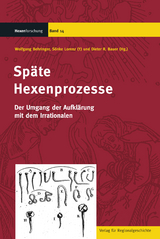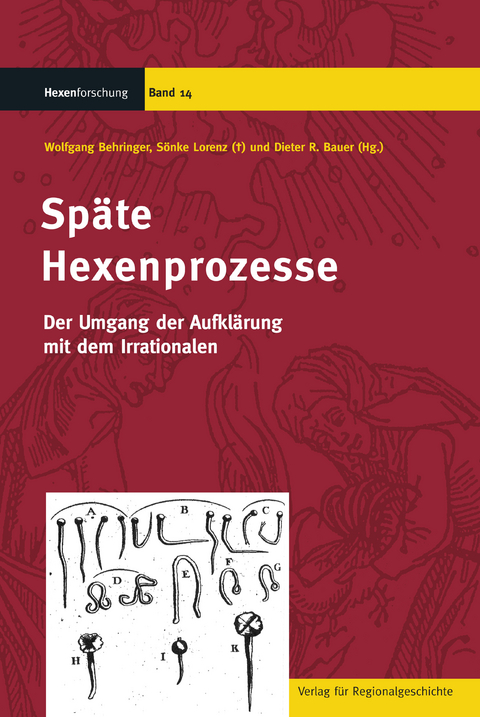Späte Hexenprozesse
Verlag für Regionalgeschichte ein Imprint von Aschendorff Verlag GmbH & Co. KG
978-3-89534-904-1 (ISBN)
Lese- und Medienproben

- Titel leider nicht mehr lieferbar
- Artikel merken
Prof. Dr. Wolfgang Behringer, Geboren 1956 in München. Professor für Geschichte der frühen Neuzeit an der Universität des Saarlandes. Forschungsschwerpunkte: Kulturgeschichte der frühen Neuzeit, insbesondere Hexenverfolgung, Post- und Klimageschichte. Mitherausgeber der »Encyclopedia of Witchcraft« und der Reihe »Hexenforschung«. https://de.wikipedia.org/wiki/Wolfgang_Behringer https://www.uni-saarland.de/lehrstuhl/frueheneuzeit/akih.html
Prof. Dr. Sönke Lorenz. Geboren 1944 in Elmshorn, gestorben 2012 in Tübingen. Professor am Institut für Geschichtliche Landeskunde und Historische Hilfswissenschaften der Universität Tübingen. Mitherausgeber der Reihe »Hexenforschung«. https://de.wikipedia.org/wiki/S%C3%B6nke_Lorenz
Dr. h.c Dieter R. Bauer. Geboren 1951 in Mühlacker. Studium: Geschichtswissenschaft, Philosophie und Mathematik in Stuttgart. Leiter des Referats Geschichte der Akademie der Diözese Rottenburg-Stuttgart; Mitbegründer der Arbeitskreise für Hexenforschung, für Hagiographie und für historische Kriminalitätsforschung. Mitherausgeber der Reihe »Hexenforschung«. https://de.wikipedia.org/wiki/Dieter_R._Bauer
Wolfgang Behringer / Sigrid Hirbodian: Das Institut für Geschichtliche Landeskunde in Tübingen • VII
Wolfgang Behringer: Späte Hexenprozesse • 1
Dries Vanysacker: The Dangers of Denying the Existence of the Devil • 25
Erika Münster-Schröer: Der Düsseldorfer Hexenprozess 1737/38 • 35
Johannes Dillinger: Der Prozess gegen Katharina Reitterin aus Eglofs 1743 • 55
Constanze Störk-Biber: Die Hexenprozesse in der Reichsabtei Marchtal 1745-1757 • 67
Klaus Graf: Der Endinger Hexenprozess gegen Anna Trutt von 1751 • 89
Wolfgang Petz: Der Fall der Anna Maria Schwägelin 1775 in der Fürstabtei Kempten • 103
Walter Hauser: Der Hexenprozess gegen Anna Göldi in der Beurteilung der Zeitgenossen • 123
Rainer Decker: Die letzten Hexenprozesse in der Schweiz (1780-1782) • 127
Philippe Bart: Hexenverfolgungen in der Innerschweiz im 18. Jahrhundert • 137
Petr Kreuz: Die späten Hexenprozesse in Böhmen und der Slowakei • 167
Jacek Wijaczka: Hexenprozesse in Polen im Zeitalter der Aufklärung • 205
Lilla Krász / Péter Tóth G.: Die Dekriminalisierung der Magie in Ungarn und in Siebenbürgen 1740-1848 • 225
H.C. Erik Midelfort: Johann Joseph Gassner und die Modernisierung der Teuflischen Besessenheit • 249
Wolfgang Schild: Hexereiprozesse nach dem Ende der Verfolgung • 257
Rainer Decker: Magieprozesse im Kirchenstaat während des 19. Jahrhunderts • 273
Christine D. Worobec: Decriminalizing Witchcraft in Pre-Emancipation Russia • 281
Barend J. ter Haar: Witchcraft in Chinese History • 309
Stephen Ellis / Gerrie ter Haar: The History of Witchcraft Accusations and Persecutions in Africa • 331
Iris Gareis: Späte Zauberei- und Hexenprozesse vor amerikanischen Inquisitionstribunalen • 347
Wolfgang Behringer: Letzte Hexenhinrichtungen 1700-1911 • 365
Autoren • 428
This is the 14th volume in the excellent »Hexenforschung«series, in which papers from the conferences organized by the Arbeitskreis für Interdisziplinäre Hexenforschung (AKIH), founded in 1985, are published. This volume draws on papers given at the AKIH conference on late witch-trials in 2005 and contains 19 essays, which are book-ended by an excellent introduction by Wolfgang Behringer, entitled »Late witch-trials – a thorn in the flesh of the Enlightenment«, and a final chapter by Behringer in which he has compiled a list of witch-trials and executions that occurred in Europe between 1700 and 1911. One of the main points that Behringer raises in his introduction is that we still know too little about these late witch-trials, and particularly about how they were entangled with the larger legal and cultural changes of the 18th and 19th centuries, and particularly in the eighteenth century with the complex set of cultural shifts we call »the Enlightenment«. The essays in this volume are invaluable in advancing our knowledge in this regard; Behringer’s hope is that future researchers will use the material generously provided in the final chapter to flesh out the picture even further.
Most of the essays deal with clusters of late witch-trials or with the iconic »last« witch-trials from various regions of 18th-century Europe, which often had particular impact on contemporaries and/or local memory or commemorative practices because they were so controversial and evoked contemporary debate or criticism. It is hard to single out individual contributions from such rich offerings, but I found those by Constance Störk-Biber on the witch-trials in the Imperial-Abbey of Marchtal (1745-1757) and Wolfgang Petz on the trial of Anna Maria Schwägelein in the Prince-Abbey of Kempten particularly interesting. Störk-Biber’s essay details the emergence during the mid-18th century Marchtal trials of legal criticism of witch-persecution and of a new willingness on the part of local elites to regard accusers of witches rather than the accused witches themselves as »evil people«; these two processes combined to bring formal prosecution to an end. The investigation by Petz of the trial of Schwägelein, who was long thought to be the last individual to suffer execution for witchcraft in the Holy Roman Empire in 1775, establishes that she won a last-minute reprieve and died in the Kempten gaol in 1781. Essays by Jacek Wijaczka on late witch-trials in Poland and Petr Kreuz on late witch-trials in Bohemia and present-day Slovakia give interesting insights into central and eastern European territories that are too often overlooked in witchcraft historiography; there is also a fascinating contribution by Iris Gareis on late trials that came before the tribunals of the Spanish Inquisition in South America.
Essays by Dries Vanysacker and H. C. Erik Midelfort focus on changing beliefs about witchcraft, the devil and demonic possession in 18th-century Europe; both show that questions about the power and existence of the devil continued to be hotly-contested topics of debate amongst the educated elites, even while large-scale witch-persecution declined and then ended and witchcraft was decriminalized. This reminds us of the need to see witch-trials on the one hand, and beliefs about witchcraft and the devil on the other, as phenomena that were interlinked but not in a simplistic causal manner; you could believe in the possibility of demonic intervention in human life in the 18th century without advocating witch-persecution. The processes of decriminalizing harmful/demonic witchcraft, and the question of how authorities then dealt with cases of alleged »superstition«, magic, or »witchcraft« are analysed in essays by Christine D. Worobec on pre-emancipation Russia, Rainer Decker on 19th-century Italy, Wolfgang Schild on Germany, and by Lilla Krász and Péter Tóth G. on Hungary and Transylvania (1740-1848); the latter essay is especially important, given that Hungary experienced its worst witch-persecution in the 18th century. Essays by Barend J. ter Haar on witchcraft in Chinese History and Stephen Ellis and Gerrie ter Haar on the history of witchcraft accusations and persecutions in Africa broaden the geographic focus still further; the latter also takes us right up to the present day, concluding that »it is possible that Africans today are more disposed than ever to consider themselves as living in a world at the mercy of witches« (p. 345). Perhaps another conference on witch-beliefs and witch-trials in global context is needed to pursue these ideas, and their links to European colonialism and its legacy, in more depth?
This is an immensely rich volume which covers a hugely impressive chronological and geographic range; I was, however, a little disappointed by the lack of engagement with the work of Ian Bostridge and Owen Davies, whose late 1990s publications on the repeal of witchcraft legislation in England in 1736 and what happened thereafter offer very helpful comparison. The essays add great detail and nuance to our understanding of the legal and cultural context of late witch-trials and of the processes and timing of the decriminalization of witchcraft. They also reminds us of the need to distinguish between the often very local and contingent nature of legal approaches to specific witch-trials, and the broader cultural context of Enlightenment debates about witchcraft and the devil; there were doubtless points at which the two intersected but these need to be teased out as carefully as possible in relation to specific events, individuals, texts, and debates. My only criticism of the volume was that there was not a stronger emphasis on the pre-18th century context. There had always been at least some parts of Europe (Rothenburg ob der Tauber, and the Palatinate for instance) where belief in witchcraft and the devil co-existed with a lack of enthusiasm for, and indeed scepticism about, judicial persecution of witches. Critical voices against legal abuses in witch-trials had also been raised from the late-16th century onwards, even though they were in a beleaguered minority to start with. Judicial scepticism in practice and writing »won out« in the 18th century, but was by no means new to it; looking back from the 18th to the 16th centuries to understand this process is thus as important as looking forward from the 18th onwards. Overall, however, »Späte Hexenprozesse« is a thought-provoking volume; it is essential reading for anyone interested in the history of witchcraft and particularly for any scholars who want to take forward the work begun here of deepening our understanding of the long-term processes of change in witch-persecution and witchcraft belief in a European and global context.
Alison Rowlands, in: Francia-Recensio 2017/2 [Frühe Neuzeit – Revolution – Empire (1500-1815)], 13.6.2017
www.perspectivia.net/publikationen/francia/francia-recensio/2017-2/fn/behringer_rowlands
»Späte Hexenprozesse« is an immensely rich volume which covers a hugely impressive chronological and geographic range. It is essential reading for anyone interested in the history of witchcraft and particularly for any scholars who want to take forward the work begun here of deepening our understanding of the long-term processes of change in witch-persecution and witchcraft belief in a European and global context.
Alison Rowlands, in: Francia-Recensio 2017/2
| Erscheint lt. Verlag | 26.1.2016 |
|---|---|
| Reihe/Serie | Hexenforschung ; 14 |
| Verlagsort | Bielefeld |
| Sprache | englisch; deutsch |
| Maße | 160 x 240 mm |
| Gewicht | 912 g |
| Einbandart | gebunden |
| Themenwelt | Geschichte ► Allgemeine Geschichte ► Neuzeit (bis 1918) |
| Geisteswissenschaften ► Geschichte ► Regional- / Ländergeschichte | |
| Geschichte ► Teilgebiete der Geschichte ► Sozialgeschichte | |
| Schlagworte | Aufklärung • Aufklärung (Zeitalter) • Deutschland • Deutschland, Geschichte; Recht • Europa • Europa, Geschichte; Recht • Hexen • Hexenprozesse • Prozesse |
| ISBN-10 | 3-89534-904-6 / 3895349046 |
| ISBN-13 | 978-3-89534-904-1 / 9783895349041 |
| Zustand | Neuware |
| Haben Sie eine Frage zum Produkt? |
aus dem Bereich



